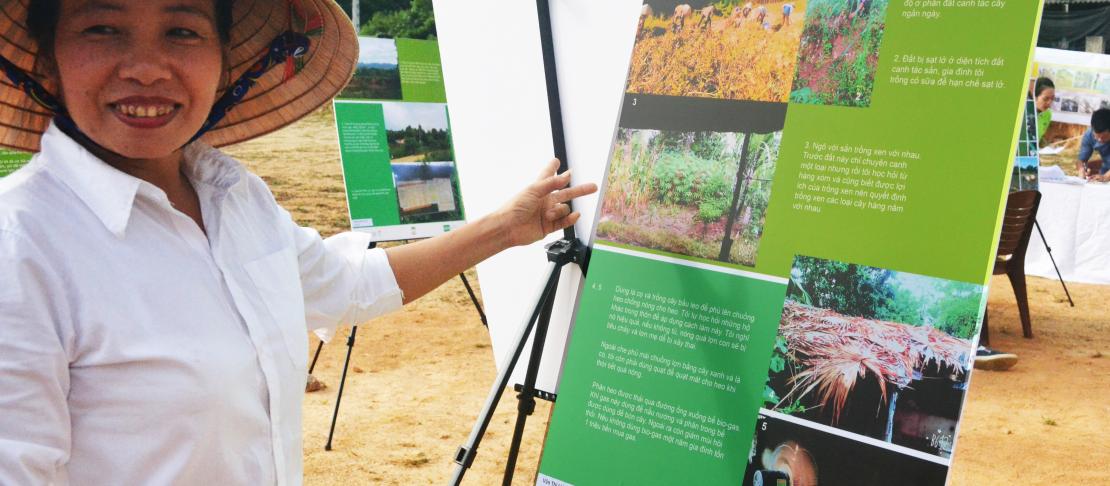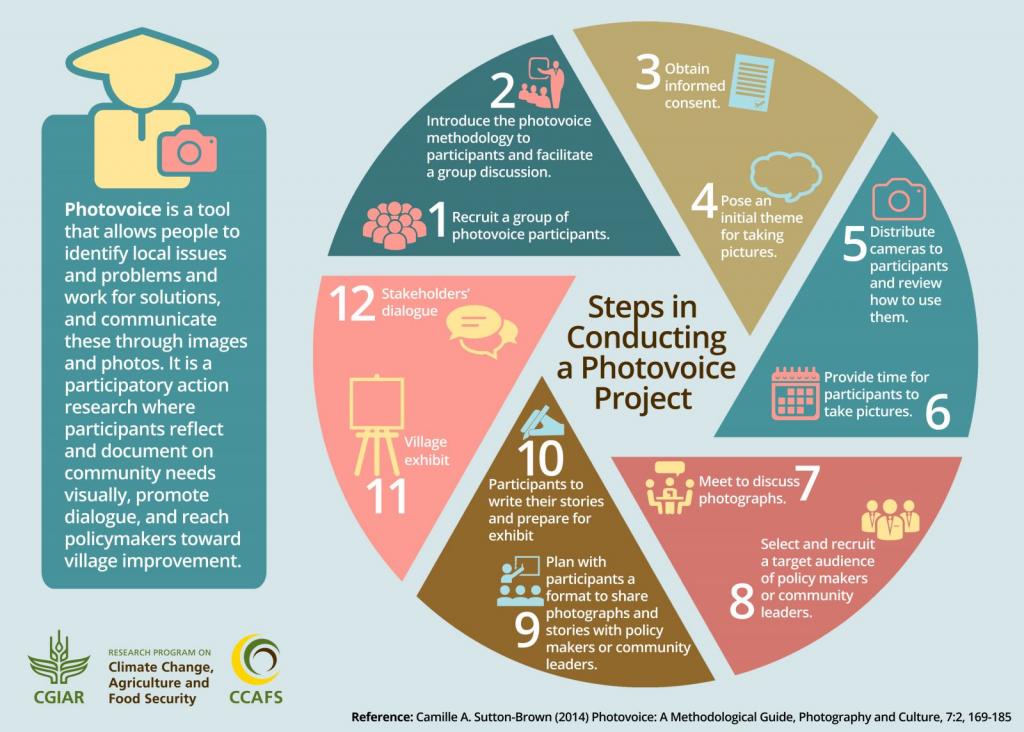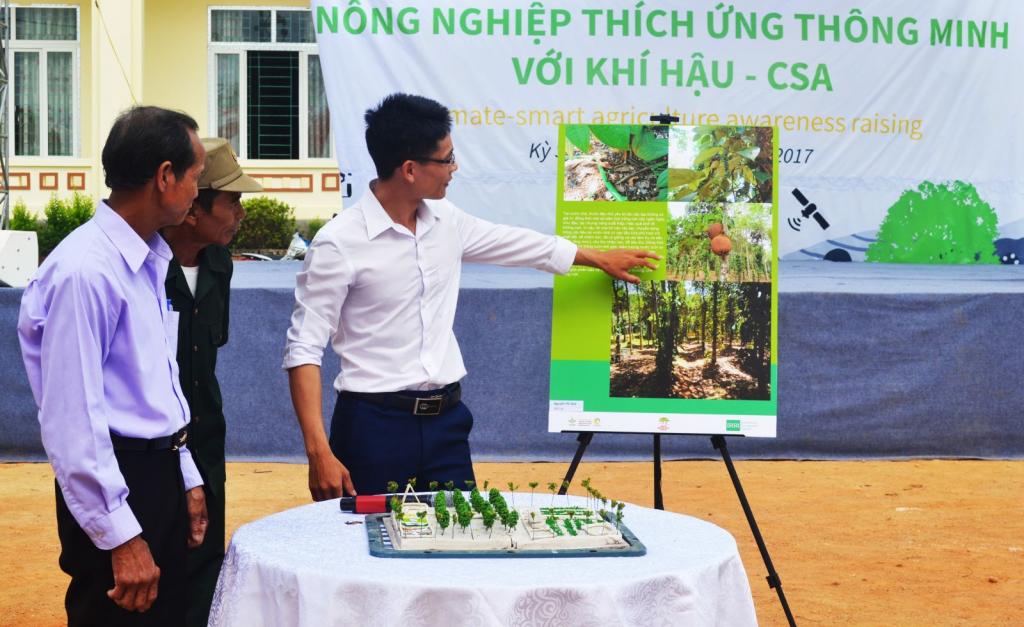A good shot for scaling up climate-smart agriculture: Photovoice in My Loi

Using photography, farmers can document the impacts of climate change on agriculture, as well as share their own adaptation efforts.
To raise awareness about the impacts of climate change and the importance of adopting climate-smart agriculture (CSA) practices, a Photovoice project was conducted in My Loi village in Ha Tinh province, Vietnam. From May to July, 24 farmers attended workshops on basic camera techniques and visual storytelling to share real-life experiences concerning food security, climate change adaptation, and GHG emission reduction.
Using photography, the farmers documented and shared their experiences with fellow farmers and policymakers. On 6 July 2017, a CSA event was organized by the World Agroforestry Centre (ICRAF), in collaboration with the Ha Tinh Farmer’s Union, Ky Son Youth Union, and Ky Son People’s Committee. One major component of the event was the Photovoice exhibition where farmers showcased and narrated their experiences using photography.
 An infograph showing the steps in conducting a Photovoice. Image: Eisen Bernardo (CCAFS SEA)
An infograph showing the steps in conducting a Photovoice. Image: Eisen Bernardo (CCAFS SEA)
The real picture
My Loi is one of the three Climate-Smart Villages (CSVs) in Vietnam under the CGIAR Research Program on Climate Change, Agriculture and Food Security (CCAFS). These sites were prioritized due to their vulnerability to specific climate challenges like droughts, floods, hot spells, and cold snaps. Because of these weather events and climate variability, the livelihoods of farmers have become more at risk.
According to Duong Van Tham, head of My Loi village,
All the posters covered the most important issues related to climate change in our commune, including flooding, riverbank erosion, drought, and hot spell. But, the photos also tackled the efforts of local farmers to adapt and mitigate those impacts.”
In his photo story, Phạm Huy Hoang recounted the effects of extreme flooding in his area, such as damaged houses, landslides, and losing arable lands. Heavy rains also affected the productivity and quality of the fruits and crops in the area. To prevent soil erosion and improve soil water-holding capacity, bamboo plantation in the landslide area along the riverbank was the adaptation measure applied by Mr. Pham.
Through her picture story, Nguyen Thị Anh also encouraged the members of the village to plant bamboo as a strategy to prevent landslides in the area. She emphasized that the affected land is quite large that requires the whole community to work together.
Nguyen Tien Minh shared some of the adaptive farming practices in his photo story. To prevent erosion during the rainy season and retain soil moisture in the dry season, he intercropped peanuts with orange trees. After harvesting peanuts, the decomposed plant residue was recycled as fertilizer for the orange trees.
Aside from the techniques and practices, information is also an essential tool for the farmers to reduce the impacts of climate change. Duong Xuan Linh showed the participants the importance of getting relevant and up-to-date climate information from the commune meteorology station and the village crop calendar.

Beyond the photographs
The Photovoice exhibition served as a knowledge-sharing platform among the farmers. About 160 participants attended the CSA event, with the hope that they become future agents of CSA outscaling in the community and nearby areas.
For Nguyen Van Tam, a visiting farmer from Ma village, “there are many agricultural practices that can be seen from the Photovoice exhibition which are more advanced than in my village, such as using drip irrigation, enhancing soil quality and fruit tree growth with Arachis pintoi, among others.” He also stated a willingness to share what the farmers in Ma are doing with farmers of Ky Son commune.
Duong Van Tham also emphasized the contribution of the Photovoice event in decision-making. He said that aside from creating awareness on climate change and its impacts to agricultural production in My Loi and neighboring villages, it is also a way to reach local authorities at all levels (provincial, district, and commune) to acknowledge the efforts of local farmers in adapting to the adverse effects of climate change.
Le Dinh Hoa, representative of the Ha Tinh Provincial Farmers Union, stressed:
Each photo story is actually the current situation at the local level. This Photovoice exhibition is a good channel to help local authorities get information from the farmers that can be used in planning and policymaking.”
Through participatory methods like the Photovoice, increased stakeholder engagement can be achieved. Le Thi Huyen, representative of the International Fund for Agricultural Development (IFAD) of Ha Tinh Province, observed that through the exhibition, she had an idea on how to engage and encourage farmers’ participation in development projects. “The Photovoice exhibition was a very open and interactive channel, making it a successful tool in disseminating information and facilitating discussion on important topics like CSA,” she shared.
Read more:
- Farmers in Ma Village to lead in outscaling climate-smart agriculture
- Models for a better future: Climate-smart agriculture is spreading
- “Please share!” – Social learning leads to greater adoption of climate-smart agriculture
Eisen Bernardo is the Senior Communication Specialist of CCAFS Southeast Asia.



